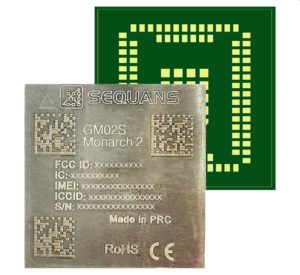LTE module from Sequans Communications reduces power consumption compared with earlier models.
 With 2G and 3G cellular networks heading off to the sunset, IoT devices need to connect to LTE or 5G networks. Given that most IoT devices don’t need 5G speeds — nor can many afford the power consumption — and that 5G networks are still in deployment, it makes sense to connect devices such as meters to LTE networks. Addressing the never-ending need to reduce power consumption, Sequans Communications has introduced the Monarch 2 GM02S, an LTE Cat M1/NB1/NB2 module. The GM02S combines an LTE modem, RF front end, and power amplifier into a single module.
With 2G and 3G cellular networks heading off to the sunset, IoT devices need to connect to LTE or 5G networks. Given that most IoT devices don’t need 5G speeds — nor can many afford the power consumption — and that 5G networks are still in deployment, it makes sense to connect devices such as meters to LTE networks. Addressing the never-ending need to reduce power consumption, Sequans Communications has introduced the Monarch 2 GM02S, an LTE Cat M1/NB1/NB2 module. The GM02S combines an LTE modem, RF front end, and power amplifier into a single module.
Sequans claims that the GM02S, based on the company’s Monarch 2 chip, which combines a modem and MCU, reduces power consumption by 60% over the previous chip. The module adds RF front and filters and +23 dBm power amplifiers to the chip, forming a complete LTE interface for low-power IoT applications. It operates on LTE bands 1, 2, 3, 4, 5, 8, 12, 13, 14, 17, 18, 19, 20, 25, 26, 28, 66, 70, 71, and 85 covering frequencies from 617 MHz to 2.2 GHz. These lower frequencies can easily handle the modules data rates of 590 kbps DL and 1.1 Mbps UL (Cat 1) and 120.7 kbps DL and 160 kbps UL (Cat NB1/NB2). Plus, you get good transmit range at these frequencies. The module operates on power-supply voltages from 2.2 V to 5.5 V, which means it can get power from AA batteries that can last for years depending on transmit power and use.
Having on onboard MCU lets you build applications for data collection from sensors. The module supports data interfaces such as JTAG, I2C, SPI, and an analog-to-digital converter (ADC). It also contains four UARTs and two SIMs (use with internal or external SIM or eSIM) and has a 50-Ω connection for an antenna. A general-purpose I/O (GPIO) port provides multiple module wake inputs and LTE-synchronized GPIO signals.
To control the internal modem, you can program the MCU to use a set of “AT” commands, which are compatible with the company’s previous generation of modems. The module also supports Internet Protocol (IP) and non-IP data delivery.


